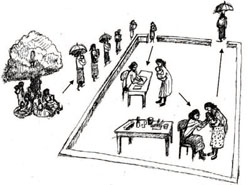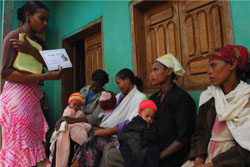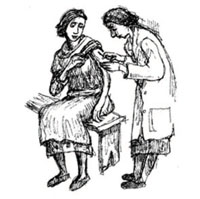8.2.1 Setting up an immunization session at a fixed site
First, you need to prepare the area where you can give the immunizations and record what you have done, and you need a waiting area for children and their caregivers. The workplace should be in the shade so that you can keep your vaccines away from direct sunlight. It is also important to keep yourself and your clients from direct sunshine, dust and rain. You have to keep the working area clean and quiet to make it conducive for your work. For efficient immunization, you need to avoid the workplace becoming crowded.
The example in Figure 8.8 shows the flow of people through a Health Post during an immunization session. Arrange the flow so that it can be in one direction only, to avoid clients who have already been vaccinated mixing with clients who are waiting for their turn.

You need a table for registration and recording and another table to put vaccines and accessories on. Ideally, there should be enough seats for carers to sit on while waiting for their turn. While they are waiting, this area can also be used to deliver information about immunization and to check the infant immunization record cards (Figure 8.9).

What resources do you need for a fixed-site immunization session?
Determine the number of vials you will need to take out of the refrigerator and place them in a vaccine carrier with the correct number of conditioned ice-packs. You should aim to open the refrigerator as few times as possible, preferably just once at the beginning and once at the end of the session. This is why it is important to estimate how many people you expect to come for vaccination at each session, so you can remove the right number of vaccine vials. Some multi-dose vials may have been opened and used in the previous session, so take them out of the ‘use first’ box and place them on the foam pad in a vaccine carrier above the conditioned ice-packs or chilled water packs.
You learned about the cold chain in Study Session 6, and about the multi-dose open vial policy in Study Session 7.

Check the quality of all vaccines and diluents as described in Study Session 6. Discard any vials or ampoules if the expiry date has passed, or if the vaccine vial monitor (VVM) has changed to the discard point, or any freeze-sensitive vaccines that have accidentally been frozen. Also discard any vaccine vial or diluent which has lost its label, because you cannot be sure what it is.
The other materials you will need for the immunization session include:
- source of water and soap for handwashing
- auto-disable (AD) syringes for immunizations and single-use disposable syringes and needles for mixing diluent with freeze-dried vaccines
- cotton swabs and antiseptic or alcohol for cleaning the skin at the injection site
- metal file to open ampoules
- stationery, including the immunization tally sheet, EPI Registration Book, pencils or pens
- new immunization cards for infants and women who have not come for immunization before
- safety boxes for syringes, needles and other sharp instruments, and another container for non-medical rubbish.
you will learn about registration and how to use the tally sheet to create your Summary Report in Study Session 10.
Deciding which vaccines to give an infant
Check which of the vaccines the infant has received before by looking at the information on the infant’s immunization card. If the carer has forgotten or lost the card, you should look for any entry for the infant in the EPI Registration Book. You can also look for a BCG scar on the upper left arm to establish if the infant has had the BCG vaccination. If the immunization card is lost, you should issue a new one. If you cannot establish whether or not the infant has been vaccinated before, it is advisable to give all the vaccines according to the national EPI schedule — unless there are contraindications. An extra dose of vaccine does not hurt most children.
Deciding whether to give a woman a TT dose

Check the immunization card of every woman of childbearing age who attends the clinic and give her the appropriate dose according to the TT schedule. If she does not have an immunization card, ask whether she has had any previous TT vaccinations, and whether she knows how many doses she has received in the past. Give her the next dose in the series. Take into account any dose given during an earlier campaign that might have taken place in your kebele. If she cannot remember or does not know, you should give her a dose of TT and advise her when to come for the next one. If she is pregnant, and has not received a TT dose in the past month, immunize her with TT vaccine.
8.2 Immunization delivery at various sites
